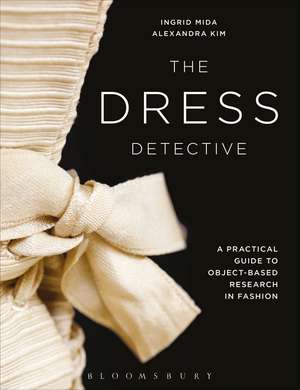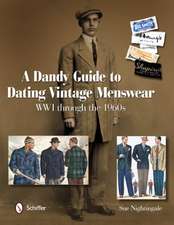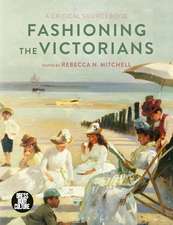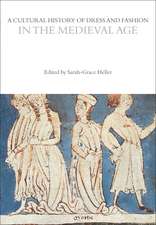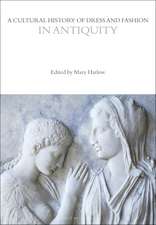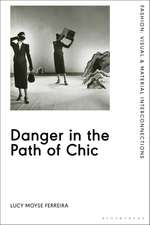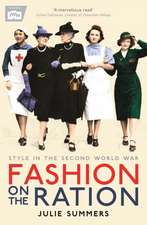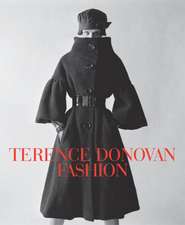The Dress Detective: A Practical Guide to Object-Based Research in Fashion
Autor Ingrid E. Mida, Alexandra Kimen Limba Engleză Paperback – 31 iul 2018
Preț: 204.45 lei
Preț vechi: 218.09 lei
-6% Nou
Puncte Express: 307
Preț estimativ în valută:
39.13€ • 40.70$ • 32.30£
39.13€ • 40.70$ • 32.30£
Carte disponibilă
Livrare economică 25 martie-08 aprilie
Livrare express 08-14 martie pentru 53.49 lei
Preluare comenzi: 021 569.72.76
Specificații
ISBN-13: 9781350087774
ISBN-10: 1350087777
Pagini: 224
Ilustrații: 150 colour illus
Dimensiuni: 189 x 246 x 20 mm
Greutate: 0.68 kg
Editura: Bloomsbury Publishing
Colecția Bloomsbury Visual Arts
Locul publicării:London, United Kingdom
ISBN-10: 1350087777
Pagini: 224
Ilustrații: 150 colour illus
Dimensiuni: 189 x 246 x 20 mm
Greutate: 0.68 kg
Editura: Bloomsbury Publishing
Colecția Bloomsbury Visual Arts
Locul publicării:London, United Kingdom
Caracteristici
Equips students with the practical knowledge to conduct professional object analysis in museums, including topics such as museum etiquette and tools of the trade
Notă biografică
Ingrid Mida is a dress historian and curator. Responsible for the revival of the Ryerson Fashion Research Collection in Canada, Mida has written for various publications including Dress, Clothing Cultures, Costume Journal, Fashion Projects, Modeconnect, Worn, and Worn Through. Alexandra Kim is a dress historian and museum professional. Kim has worked at the Ashmolean, Chertsey Museum, and Buckinghamshire County Museum and was most recently a curator at Kensington Palace, UK. She now combines research and writing with her work as an editor of Costume, the journal of the UK Costume Society.
Cuprins
Foreword, Jean L. Druesedow, Kent State University Museum, USAAcknowledgmentsIntroductionChapter 1: A Brief History of Object-based Research with Dress ArtifactsChapter 2: How to Read a Dress ArtifactChapter 3: ObservationChapter 4: ReflectionChapter 5: InterpretationChapter 6: Case Study of a Yellow Woolen PelisseChapter 7: Case Study of a Gray-blue Sateen CorsetChapter 8: Case Study of a Brown Velveteen and Wool BodiceChapter 9: Case study of a Man's Evening Suit Tailcoat and TrousersChapter 10: Case Study of a Lanvin Wedding Dress and HeadpieceChapter 11: Case Study of a Ruby Red Velvet Jacket by Christian Dior Chapter 12: Case study of a Kimono-Style Jacket by KenzoAppendix 1: Checklist for ObservationAppendix 2: Checklist for ReflectionIndex
Recenzii
Detective work is integral to fashion history research, yet very little has been written on how to go about it. Ingrid Mida and Alexandra Kim fill that gap in the bookshelf with The Dress Detective. . A concise, well organized, and extremely accessible book that deserves a place on the bookshelf of anyone interested in fashion research.
Both accessible and academic and a significant contribution to the study of [the history of Western dress] ... This book is well designed and a pleasure to look at. It functions as a practical manual, a 'how to' book, a reference work and an enjoyable read for anyone interested in this subject.
Enormously useful for the budding fashion historian or curator, this publication provides a textbook approach to the study of dress artefacts as a source for research. The authors, both of whom have curatorial backgrounds, provide a practice-based framework and a range of interesting case studies to instruct readers in the methods for observing and reflecting upon objects of dress. This accessible guide will surely become a crucial source for students of fashion studies.
For post-secondary students on fashion courses with access to study garments, or for the novice researcher investigating in a museum or private collection, this book would be an invaluable resource. Even individuals with experience in handling fashion objects may glean new tips, or be reminded of best practice when closely examining dress objects, or in relating these findings to broader socio-economic, historical, or theoretical contexts. This book would also be a useful addition to the shelf of fashion collections in museums, to assist when training staff and volunteers in collection inventory or exhibit preparation. The Dress Detective gives clear clues to becoming a sartorial sleuth.
The Dress Detective provides an easy-to-use guide for how to look at a dress object and to consider its meaning. The framework, which the authors call "a slow approach to seeing," involves three steps: observation, reflection, and interpretation. It is a revision of Prown's model of description, deduction, and speculation.
For the first time, The Dress Detective offers a clear and systematic framework for the object-based study of dress. Advocating a 'Slow Approach to Seeing', it arms readers with the tools to learn this important research skill while encouraging them through well-chosen case studies to measure their findings against inter-disciplinary and theoretical writing on fashion.
This is the book we have been waiting for without realizing it! The Dress Detective offers a rigorous and entirely accessible guide to examining and thinking about dress using objects as evidence. Case studies and checklists guide the reader - specialist and non-specialist alike - to explore and articulate garment construction, materials, design, alterations and the nuances of wear. I have no doubt it will become a seminal text.
The Dress Detective is a smart, accessible text that provides a long-overdue methodology for examining clothing and accessories. This book is essential for new students, but its concise framework will also be useful to seasoned researchers. Diverse, thorough case studies demonstrate the combination of visual analysis, history, and theory that is crucial to fashion studies today.
A long-anticipated guide to object-based dress research . I recommend this outstanding volume to students and faculty alike.
This book operates as a kind of practical aid, offering a comprehensive methodological framework to both scholars and students.
Both accessible and academic and a significant contribution to the study of [the history of Western dress] ... This book is well designed and a pleasure to look at. It functions as a practical manual, a 'how to' book, a reference work and an enjoyable read for anyone interested in this subject.
Enormously useful for the budding fashion historian or curator, this publication provides a textbook approach to the study of dress artefacts as a source for research. The authors, both of whom have curatorial backgrounds, provide a practice-based framework and a range of interesting case studies to instruct readers in the methods for observing and reflecting upon objects of dress. This accessible guide will surely become a crucial source for students of fashion studies.
For post-secondary students on fashion courses with access to study garments, or for the novice researcher investigating in a museum or private collection, this book would be an invaluable resource. Even individuals with experience in handling fashion objects may glean new tips, or be reminded of best practice when closely examining dress objects, or in relating these findings to broader socio-economic, historical, or theoretical contexts. This book would also be a useful addition to the shelf of fashion collections in museums, to assist when training staff and volunteers in collection inventory or exhibit preparation. The Dress Detective gives clear clues to becoming a sartorial sleuth.
The Dress Detective provides an easy-to-use guide for how to look at a dress object and to consider its meaning. The framework, which the authors call "a slow approach to seeing," involves three steps: observation, reflection, and interpretation. It is a revision of Prown's model of description, deduction, and speculation.
For the first time, The Dress Detective offers a clear and systematic framework for the object-based study of dress. Advocating a 'Slow Approach to Seeing', it arms readers with the tools to learn this important research skill while encouraging them through well-chosen case studies to measure their findings against inter-disciplinary and theoretical writing on fashion.
This is the book we have been waiting for without realizing it! The Dress Detective offers a rigorous and entirely accessible guide to examining and thinking about dress using objects as evidence. Case studies and checklists guide the reader - specialist and non-specialist alike - to explore and articulate garment construction, materials, design, alterations and the nuances of wear. I have no doubt it will become a seminal text.
The Dress Detective is a smart, accessible text that provides a long-overdue methodology for examining clothing and accessories. This book is essential for new students, but its concise framework will also be useful to seasoned researchers. Diverse, thorough case studies demonstrate the combination of visual analysis, history, and theory that is crucial to fashion studies today.
A long-anticipated guide to object-based dress research . I recommend this outstanding volume to students and faculty alike.
This book operates as a kind of practical aid, offering a comprehensive methodological framework to both scholars and students.
